Warehouse Management Report: Processes, Systems, and Order Picking
VerifiedAdded on 2020/06/06
|9
|2122
|37
Report
AI Summary
This report provides a detailed analysis of warehouse management, encompassing its definition, operations, and the role of warehouse managers. It explores the functions of warehouse management systems (WMS), including inventory management, receiving, shipping, and safety protocols. The report further examines the processes within a warehouse, such as inbound and outbound operations, storage methods, and the equipment used. It also discusses order picking methods, including single order, batch, and zone picking, along with their respective advantages and disadvantages. The report highlights the critical role of WMS in optimizing warehouse efficiency, covering aspects like inventory tracking, labor visibility, and document preparation. It concludes by summarizing the key takeaways, emphasizing the importance of effective warehouse management for business success.
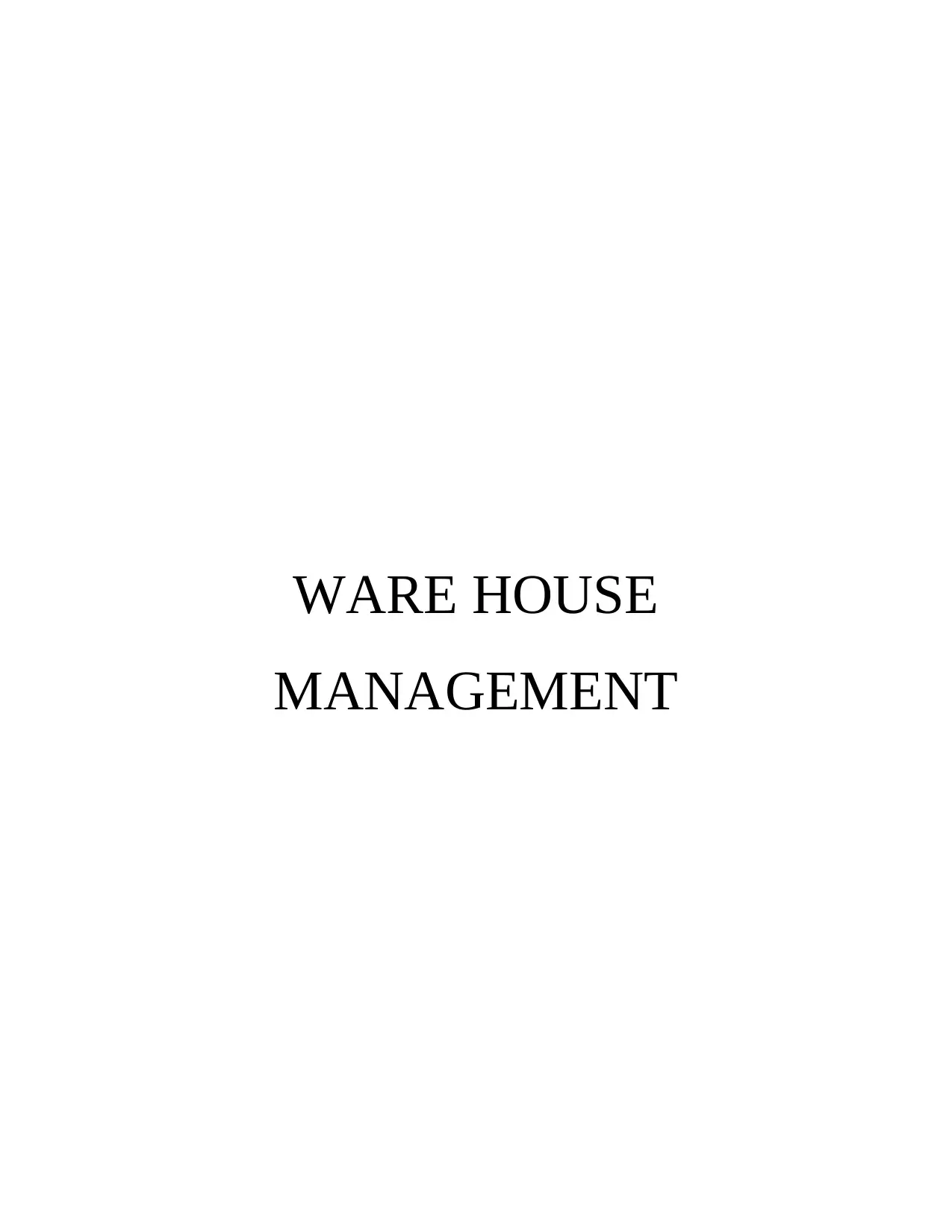
WARE HOUSE
MANAGEMENT
MANAGEMENT
Paraphrase This Document
Need a fresh take? Get an instant paraphrase of this document with our AI Paraphraser
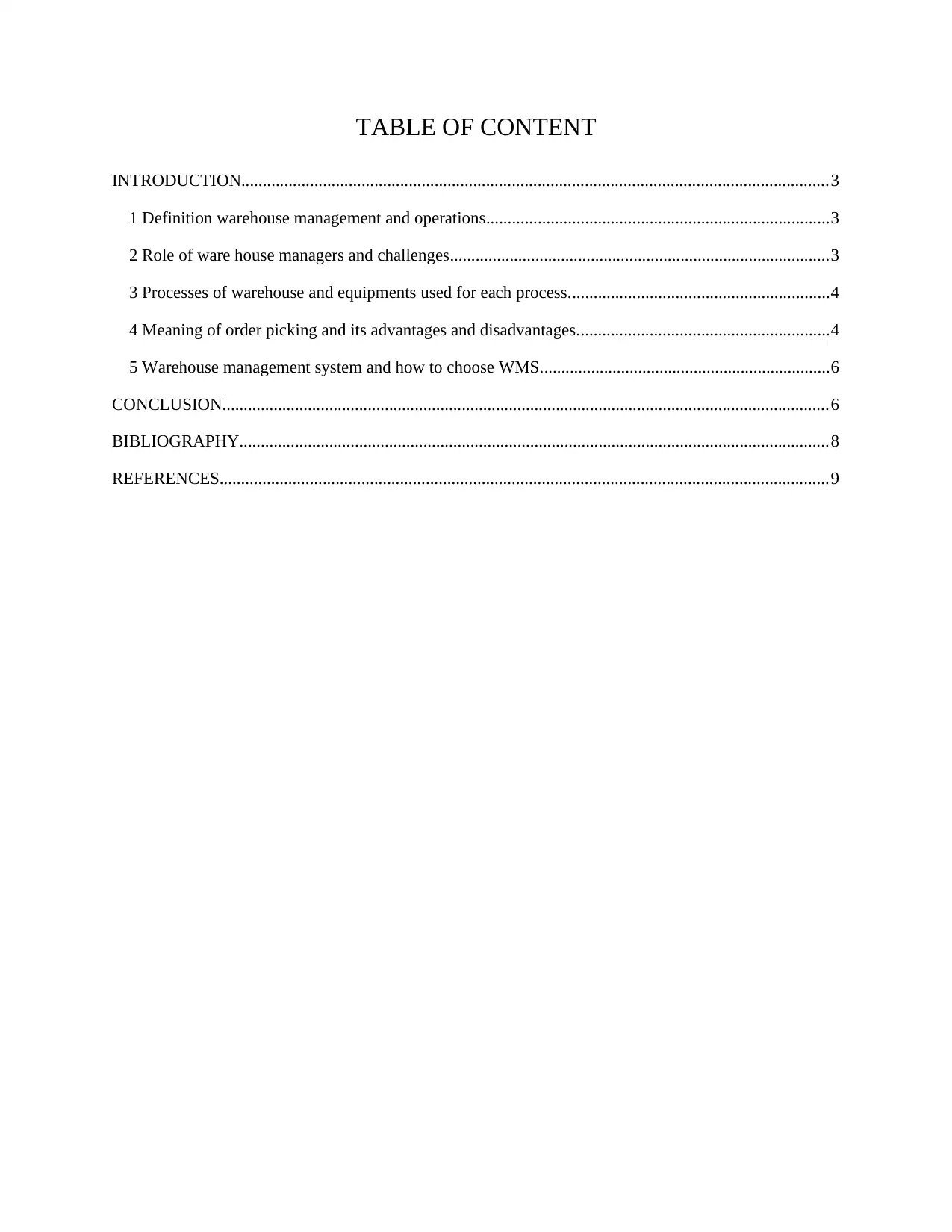
TABLE OF CONTENT
INTRODUCTION.........................................................................................................................................3
1 Definition warehouse management and operations................................................................................3
2 Role of ware house managers and challenges.........................................................................................3
3 Processes of warehouse and equipments used for each process.............................................................4
4 Meaning of order picking and its advantages and disadvantages...........................................................4
5 Warehouse management system and how to choose WMS....................................................................6
CONCLUSION..............................................................................................................................................6
BIBLIOGRAPHY..........................................................................................................................................8
REFERENCES..............................................................................................................................................9
INTRODUCTION.........................................................................................................................................3
1 Definition warehouse management and operations................................................................................3
2 Role of ware house managers and challenges.........................................................................................3
3 Processes of warehouse and equipments used for each process.............................................................4
4 Meaning of order picking and its advantages and disadvantages...........................................................4
5 Warehouse management system and how to choose WMS....................................................................6
CONCLUSION..............................................................................................................................................6
BIBLIOGRAPHY..........................................................................................................................................8
REFERENCES..............................................................................................................................................9
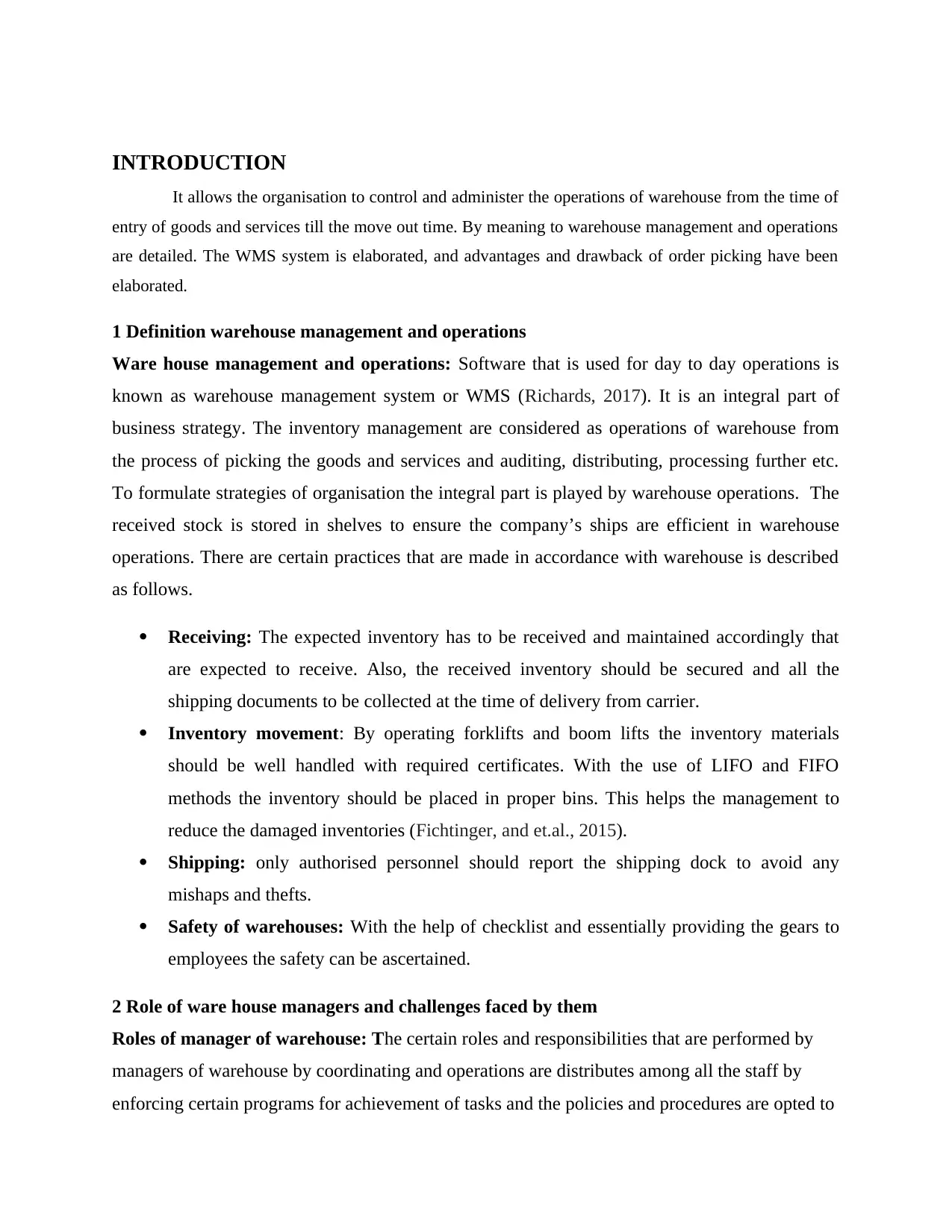
INTRODUCTION
It allows the organisation to control and administer the operations of warehouse from the time of
entry of goods and services till the move out time. By meaning to warehouse management and operations
are detailed. The WMS system is elaborated, and advantages and drawback of order picking have been
elaborated.
1 Definition warehouse management and operations
Ware house management and operations: Software that is used for day to day operations is
known as warehouse management system or WMS (Richards, 2017). It is an integral part of
business strategy. The inventory management are considered as operations of warehouse from
the process of picking the goods and services and auditing, distributing, processing further etc.
To formulate strategies of organisation the integral part is played by warehouse operations. The
received stock is stored in shelves to ensure the company’s ships are efficient in warehouse
operations. There are certain practices that are made in accordance with warehouse is described
as follows.
Receiving: The expected inventory has to be received and maintained accordingly that
are expected to receive. Also, the received inventory should be secured and all the
shipping documents to be collected at the time of delivery from carrier.
Inventory movement: By operating forklifts and boom lifts the inventory materials
should be well handled with required certificates. With the use of LIFO and FIFO
methods the inventory should be placed in proper bins. This helps the management to
reduce the damaged inventories (Fichtinger, and et.al., 2015).
Shipping: only authorised personnel should report the shipping dock to avoid any
mishaps and thefts.
Safety of warehouses: With the help of checklist and essentially providing the gears to
employees the safety can be ascertained.
2 Role of ware house managers and challenges faced by them
Roles of manager of warehouse: The certain roles and responsibilities that are performed by
managers of warehouse by coordinating and operations are distributes among all the staff by
enforcing certain programs for achievement of tasks and the policies and procedures are opted to
It allows the organisation to control and administer the operations of warehouse from the time of
entry of goods and services till the move out time. By meaning to warehouse management and operations
are detailed. The WMS system is elaborated, and advantages and drawback of order picking have been
elaborated.
1 Definition warehouse management and operations
Ware house management and operations: Software that is used for day to day operations is
known as warehouse management system or WMS (Richards, 2017). It is an integral part of
business strategy. The inventory management are considered as operations of warehouse from
the process of picking the goods and services and auditing, distributing, processing further etc.
To formulate strategies of organisation the integral part is played by warehouse operations. The
received stock is stored in shelves to ensure the company’s ships are efficient in warehouse
operations. There are certain practices that are made in accordance with warehouse is described
as follows.
Receiving: The expected inventory has to be received and maintained accordingly that
are expected to receive. Also, the received inventory should be secured and all the
shipping documents to be collected at the time of delivery from carrier.
Inventory movement: By operating forklifts and boom lifts the inventory materials
should be well handled with required certificates. With the use of LIFO and FIFO
methods the inventory should be placed in proper bins. This helps the management to
reduce the damaged inventories (Fichtinger, and et.al., 2015).
Shipping: only authorised personnel should report the shipping dock to avoid any
mishaps and thefts.
Safety of warehouses: With the help of checklist and essentially providing the gears to
employees the safety can be ascertained.
2 Role of ware house managers and challenges faced by them
Roles of manager of warehouse: The certain roles and responsibilities that are performed by
managers of warehouse by coordinating and operations are distributes among all the staff by
enforcing certain programs for achievement of tasks and the policies and procedures are opted to
⊘ This is a preview!⊘
Do you want full access?
Subscribe today to unlock all pages.

Trusted by 1+ million students worldwide
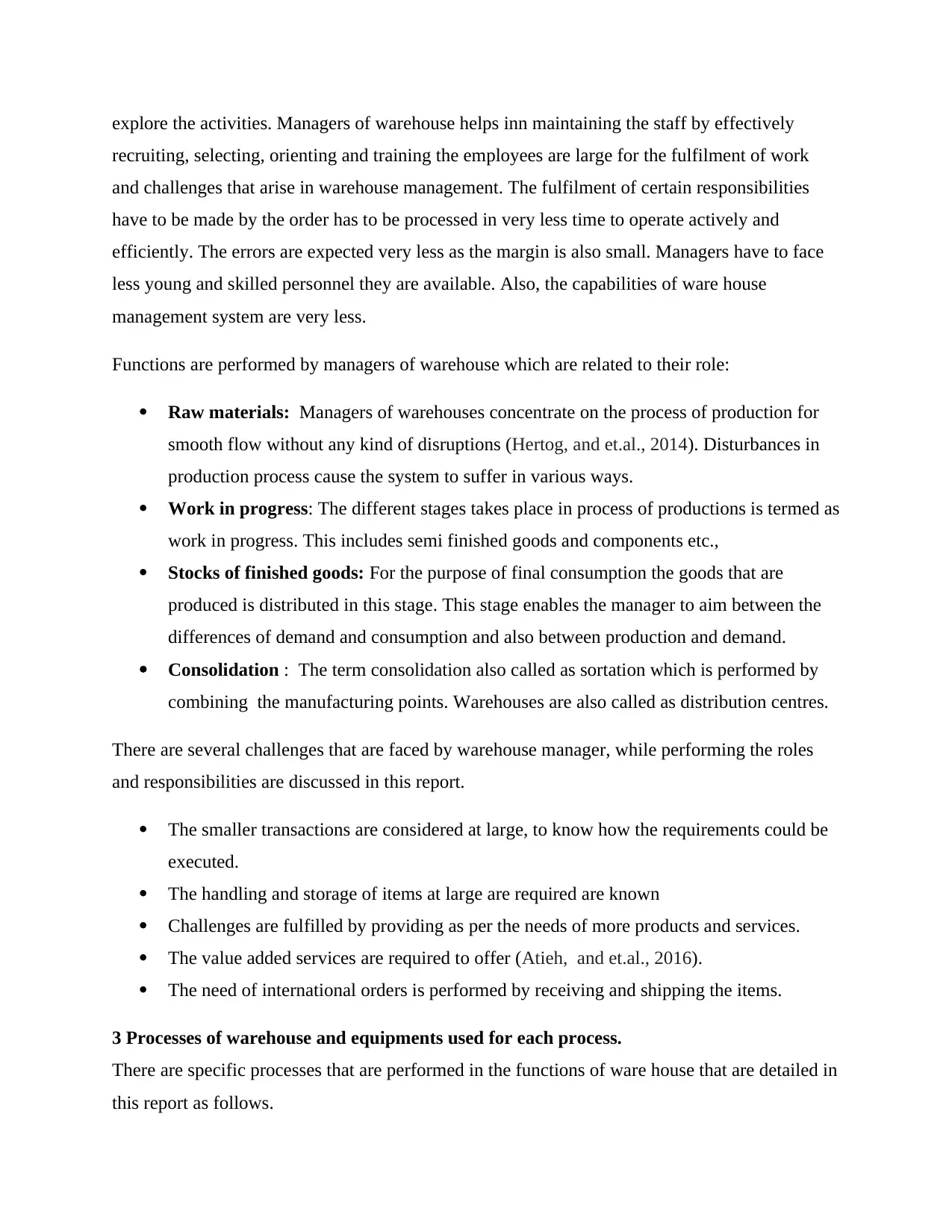
explore the activities. Managers of warehouse helps inn maintaining the staff by effectively
recruiting, selecting, orienting and training the employees are large for the fulfilment of work
and challenges that arise in warehouse management. The fulfilment of certain responsibilities
have to be made by the order has to be processed in very less time to operate actively and
efficiently. The errors are expected very less as the margin is also small. Managers have to face
less young and skilled personnel they are available. Also, the capabilities of ware house
management system are very less.
Functions are performed by managers of warehouse which are related to their role:
Raw materials: Managers of warehouses concentrate on the process of production for
smooth flow without any kind of disruptions (Hertog, and et.al., 2014). Disturbances in
production process cause the system to suffer in various ways.
Work in progress: The different stages takes place in process of productions is termed as
work in progress. This includes semi finished goods and components etc.,
Stocks of finished goods: For the purpose of final consumption the goods that are
produced is distributed in this stage. This stage enables the manager to aim between the
differences of demand and consumption and also between production and demand.
Consolidation : The term consolidation also called as sortation which is performed by
combining the manufacturing points. Warehouses are also called as distribution centres.
There are several challenges that are faced by warehouse manager, while performing the roles
and responsibilities are discussed in this report.
The smaller transactions are considered at large, to know how the requirements could be
executed.
The handling and storage of items at large are required are known
Challenges are fulfilled by providing as per the needs of more products and services.
The value added services are required to offer (Atieh, and et.al., 2016).
The need of international orders is performed by receiving and shipping the items.
3 Processes of warehouse and equipments used for each process.
There are specific processes that are performed in the functions of ware house that are detailed in
this report as follows.
recruiting, selecting, orienting and training the employees are large for the fulfilment of work
and challenges that arise in warehouse management. The fulfilment of certain responsibilities
have to be made by the order has to be processed in very less time to operate actively and
efficiently. The errors are expected very less as the margin is also small. Managers have to face
less young and skilled personnel they are available. Also, the capabilities of ware house
management system are very less.
Functions are performed by managers of warehouse which are related to their role:
Raw materials: Managers of warehouses concentrate on the process of production for
smooth flow without any kind of disruptions (Hertog, and et.al., 2014). Disturbances in
production process cause the system to suffer in various ways.
Work in progress: The different stages takes place in process of productions is termed as
work in progress. This includes semi finished goods and components etc.,
Stocks of finished goods: For the purpose of final consumption the goods that are
produced is distributed in this stage. This stage enables the manager to aim between the
differences of demand and consumption and also between production and demand.
Consolidation : The term consolidation also called as sortation which is performed by
combining the manufacturing points. Warehouses are also called as distribution centres.
There are several challenges that are faced by warehouse manager, while performing the roles
and responsibilities are discussed in this report.
The smaller transactions are considered at large, to know how the requirements could be
executed.
The handling and storage of items at large are required are known
Challenges are fulfilled by providing as per the needs of more products and services.
The value added services are required to offer (Atieh, and et.al., 2016).
The need of international orders is performed by receiving and shipping the items.
3 Processes of warehouse and equipments used for each process.
There are specific processes that are performed in the functions of ware house that are detailed in
this report as follows.
Paraphrase This Document
Need a fresh take? Get an instant paraphrase of this document with our AI Paraphraser
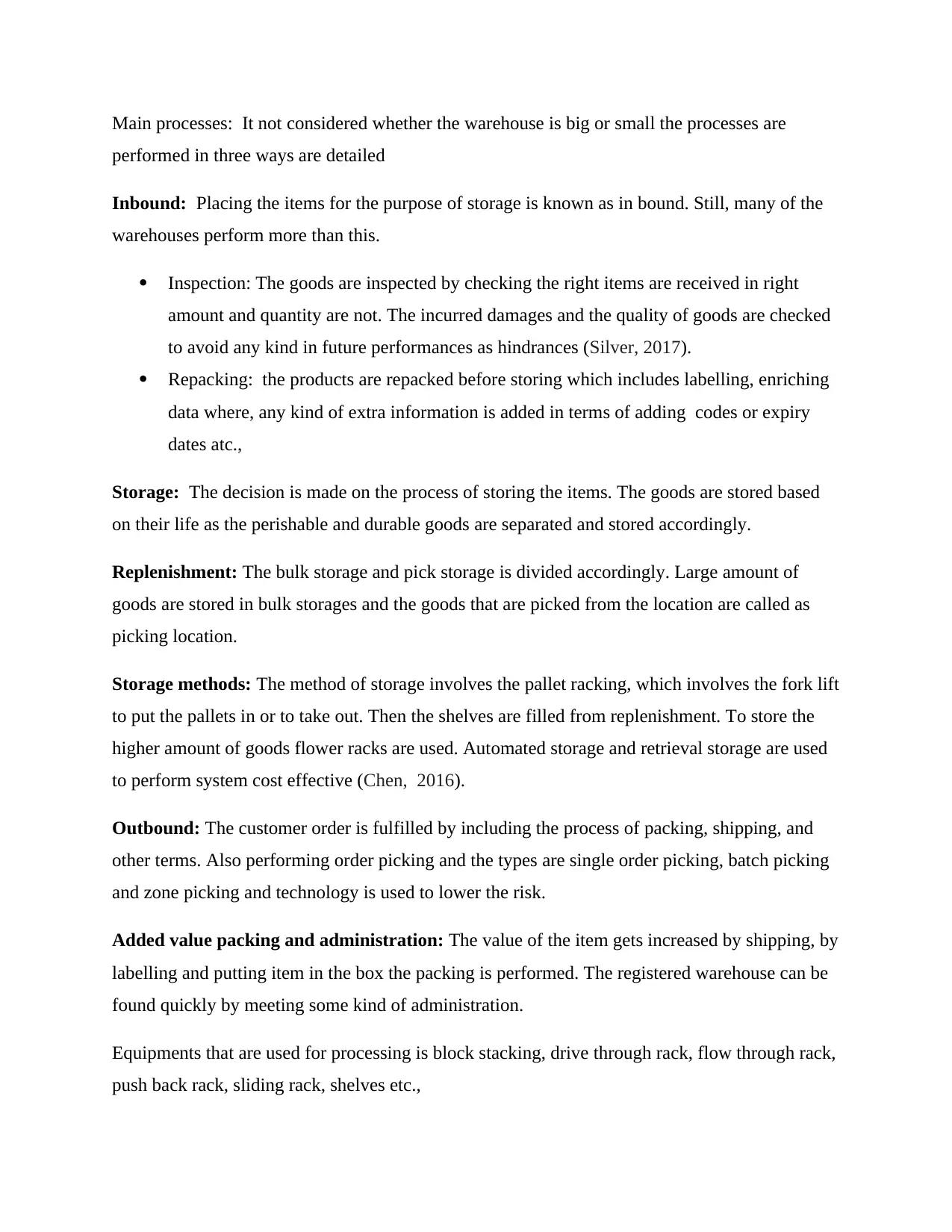
Main processes: It not considered whether the warehouse is big or small the processes are
performed in three ways are detailed
Inbound: Placing the items for the purpose of storage is known as in bound. Still, many of the
warehouses perform more than this.
Inspection: The goods are inspected by checking the right items are received in right
amount and quantity are not. The incurred damages and the quality of goods are checked
to avoid any kind in future performances as hindrances (Silver, 2017).
Repacking: the products are repacked before storing which includes labelling, enriching
data where, any kind of extra information is added in terms of adding codes or expiry
dates atc.,
Storage: The decision is made on the process of storing the items. The goods are stored based
on their life as the perishable and durable goods are separated and stored accordingly.
Replenishment: The bulk storage and pick storage is divided accordingly. Large amount of
goods are stored in bulk storages and the goods that are picked from the location are called as
picking location.
Storage methods: The method of storage involves the pallet racking, which involves the fork lift
to put the pallets in or to take out. Then the shelves are filled from replenishment. To store the
higher amount of goods flower racks are used. Automated storage and retrieval storage are used
to perform system cost effective (Chen, 2016).
Outbound: The customer order is fulfilled by including the process of packing, shipping, and
other terms. Also performing order picking and the types are single order picking, batch picking
and zone picking and technology is used to lower the risk.
Added value packing and administration: The value of the item gets increased by shipping, by
labelling and putting item in the box the packing is performed. The registered warehouse can be
found quickly by meeting some kind of administration.
Equipments that are used for processing is block stacking, drive through rack, flow through rack,
push back rack, sliding rack, shelves etc.,
performed in three ways are detailed
Inbound: Placing the items for the purpose of storage is known as in bound. Still, many of the
warehouses perform more than this.
Inspection: The goods are inspected by checking the right items are received in right
amount and quantity are not. The incurred damages and the quality of goods are checked
to avoid any kind in future performances as hindrances (Silver, 2017).
Repacking: the products are repacked before storing which includes labelling, enriching
data where, any kind of extra information is added in terms of adding codes or expiry
dates atc.,
Storage: The decision is made on the process of storing the items. The goods are stored based
on their life as the perishable and durable goods are separated and stored accordingly.
Replenishment: The bulk storage and pick storage is divided accordingly. Large amount of
goods are stored in bulk storages and the goods that are picked from the location are called as
picking location.
Storage methods: The method of storage involves the pallet racking, which involves the fork lift
to put the pallets in or to take out. Then the shelves are filled from replenishment. To store the
higher amount of goods flower racks are used. Automated storage and retrieval storage are used
to perform system cost effective (Chen, 2016).
Outbound: The customer order is fulfilled by including the process of packing, shipping, and
other terms. Also performing order picking and the types are single order picking, batch picking
and zone picking and technology is used to lower the risk.
Added value packing and administration: The value of the item gets increased by shipping, by
labelling and putting item in the box the packing is performed. The registered warehouse can be
found quickly by meeting some kind of administration.
Equipments that are used for processing is block stacking, drive through rack, flow through rack,
push back rack, sliding rack, shelves etc.,
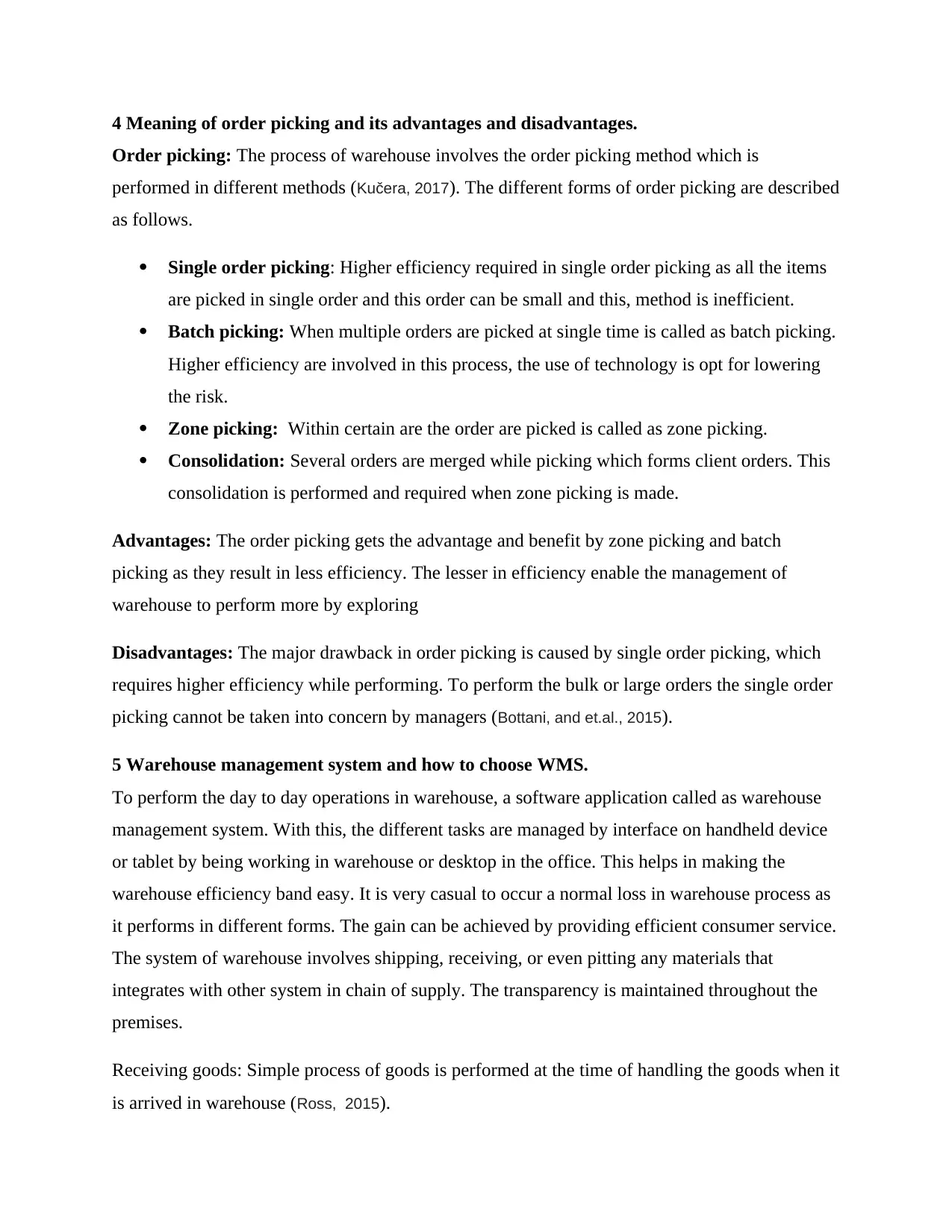
4 Meaning of order picking and its advantages and disadvantages.
Order picking: The process of warehouse involves the order picking method which is
performed in different methods (Kučera, 2017). The different forms of order picking are described
as follows.
Single order picking: Higher efficiency required in single order picking as all the items
are picked in single order and this order can be small and this, method is inefficient.
Batch picking: When multiple orders are picked at single time is called as batch picking.
Higher efficiency are involved in this process, the use of technology is opt for lowering
the risk.
Zone picking: Within certain are the order are picked is called as zone picking.
Consolidation: Several orders are merged while picking which forms client orders. This
consolidation is performed and required when zone picking is made.
Advantages: The order picking gets the advantage and benefit by zone picking and batch
picking as they result in less efficiency. The lesser in efficiency enable the management of
warehouse to perform more by exploring
Disadvantages: The major drawback in order picking is caused by single order picking, which
requires higher efficiency while performing. To perform the bulk or large orders the single order
picking cannot be taken into concern by managers (Bottani, and et.al., 2015).
5 Warehouse management system and how to choose WMS.
To perform the day to day operations in warehouse, a software application called as warehouse
management system. With this, the different tasks are managed by interface on handheld device
or tablet by being working in warehouse or desktop in the office. This helps in making the
warehouse efficiency band easy. It is very casual to occur a normal loss in warehouse process as
it performs in different forms. The gain can be achieved by providing efficient consumer service.
The system of warehouse involves shipping, receiving, or even pitting any materials that
integrates with other system in chain of supply. The transparency is maintained throughout the
premises.
Receiving goods: Simple process of goods is performed at the time of handling the goods when it
is arrived in warehouse (Ross, 2015).
Order picking: The process of warehouse involves the order picking method which is
performed in different methods (Kučera, 2017). The different forms of order picking are described
as follows.
Single order picking: Higher efficiency required in single order picking as all the items
are picked in single order and this order can be small and this, method is inefficient.
Batch picking: When multiple orders are picked at single time is called as batch picking.
Higher efficiency are involved in this process, the use of technology is opt for lowering
the risk.
Zone picking: Within certain are the order are picked is called as zone picking.
Consolidation: Several orders are merged while picking which forms client orders. This
consolidation is performed and required when zone picking is made.
Advantages: The order picking gets the advantage and benefit by zone picking and batch
picking as they result in less efficiency. The lesser in efficiency enable the management of
warehouse to perform more by exploring
Disadvantages: The major drawback in order picking is caused by single order picking, which
requires higher efficiency while performing. To perform the bulk or large orders the single order
picking cannot be taken into concern by managers (Bottani, and et.al., 2015).
5 Warehouse management system and how to choose WMS.
To perform the day to day operations in warehouse, a software application called as warehouse
management system. With this, the different tasks are managed by interface on handheld device
or tablet by being working in warehouse or desktop in the office. This helps in making the
warehouse efficiency band easy. It is very casual to occur a normal loss in warehouse process as
it performs in different forms. The gain can be achieved by providing efficient consumer service.
The system of warehouse involves shipping, receiving, or even pitting any materials that
integrates with other system in chain of supply. The transparency is maintained throughout the
premises.
Receiving goods: Simple process of goods is performed at the time of handling the goods when it
is arrived in warehouse (Ross, 2015).
⊘ This is a preview!⊘
Do you want full access?
Subscribe today to unlock all pages.

Trusted by 1+ million students worldwide
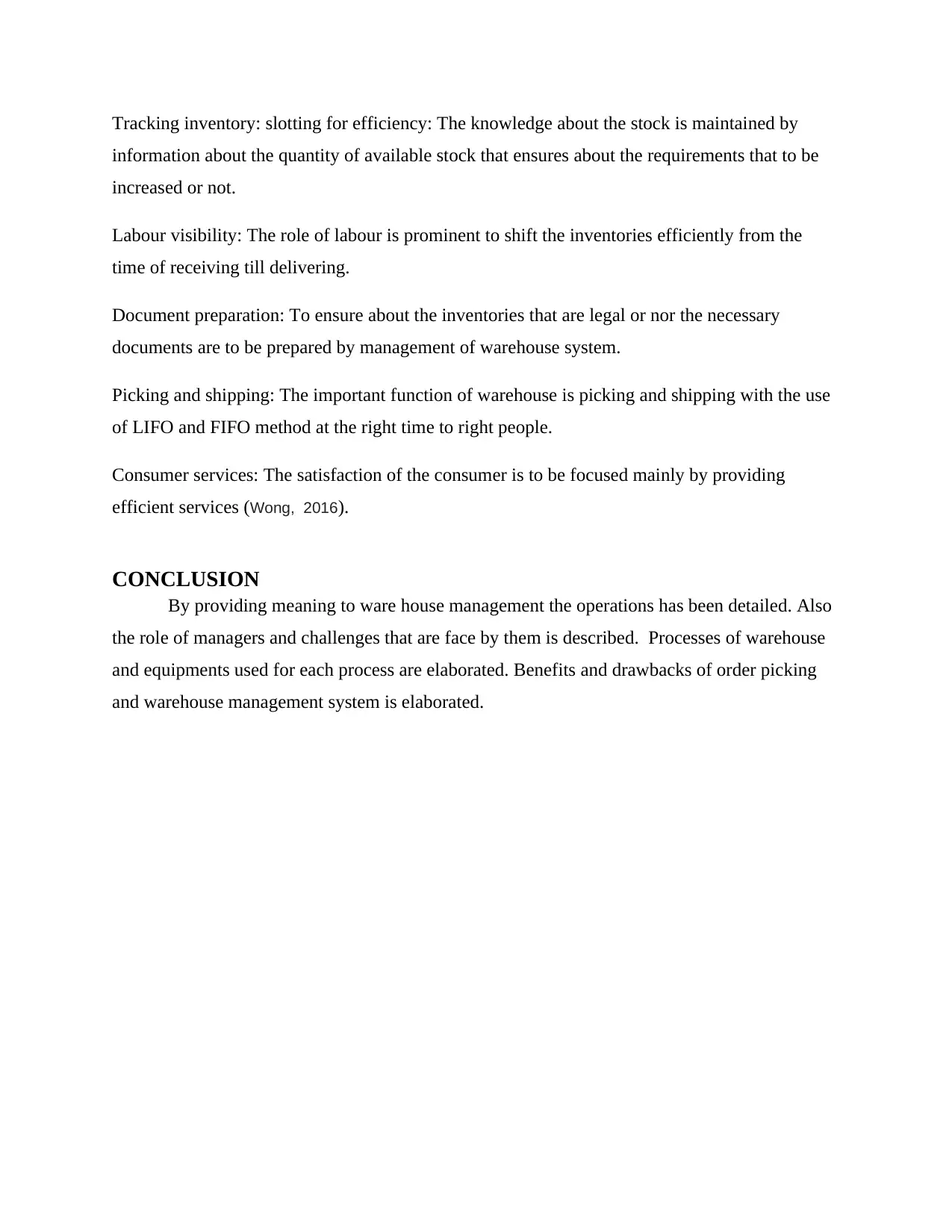
Tracking inventory: slotting for efficiency: The knowledge about the stock is maintained by
information about the quantity of available stock that ensures about the requirements that to be
increased or not.
Labour visibility: The role of labour is prominent to shift the inventories efficiently from the
time of receiving till delivering.
Document preparation: To ensure about the inventories that are legal or nor the necessary
documents are to be prepared by management of warehouse system.
Picking and shipping: The important function of warehouse is picking and shipping with the use
of LIFO and FIFO method at the right time to right people.
Consumer services: The satisfaction of the consumer is to be focused mainly by providing
efficient services (Wong, 2016).
CONCLUSION
By providing meaning to ware house management the operations has been detailed. Also
the role of managers and challenges that are face by them is described. Processes of warehouse
and equipments used for each process are elaborated. Benefits and drawbacks of order picking
and warehouse management system is elaborated.
information about the quantity of available stock that ensures about the requirements that to be
increased or not.
Labour visibility: The role of labour is prominent to shift the inventories efficiently from the
time of receiving till delivering.
Document preparation: To ensure about the inventories that are legal or nor the necessary
documents are to be prepared by management of warehouse system.
Picking and shipping: The important function of warehouse is picking and shipping with the use
of LIFO and FIFO method at the right time to right people.
Consumer services: The satisfaction of the consumer is to be focused mainly by providing
efficient services (Wong, 2016).
CONCLUSION
By providing meaning to ware house management the operations has been detailed. Also
the role of managers and challenges that are face by them is described. Processes of warehouse
and equipments used for each process are elaborated. Benefits and drawbacks of order picking
and warehouse management system is elaborated.
Paraphrase This Document
Need a fresh take? Get an instant paraphrase of this document with our AI Paraphraser
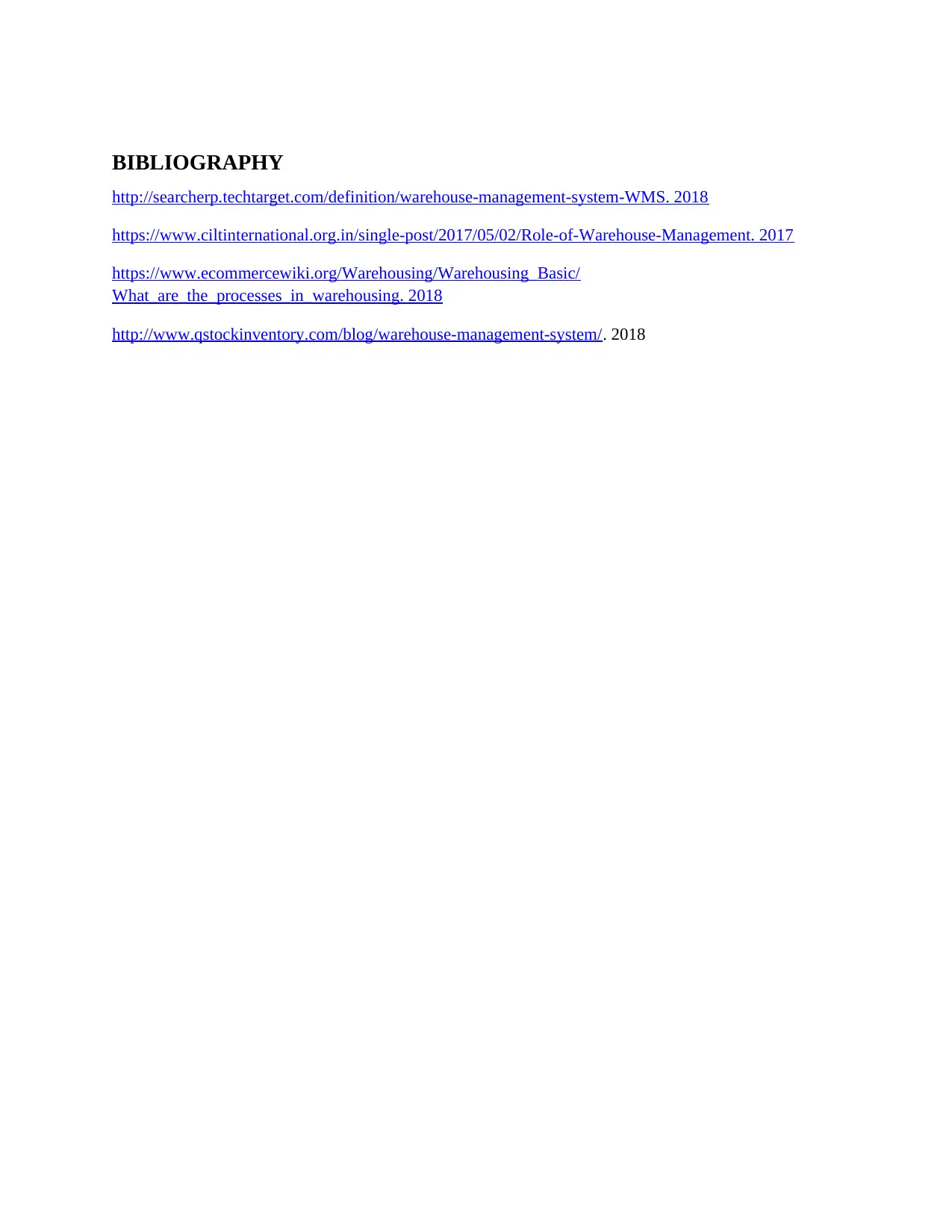
BIBLIOGRAPHY
http://searcherp.techtarget.com/definition/warehouse-management-system-WMS. 2018
https://www.ciltinternational.org.in/single-post/2017/05/02/Role-of-Warehouse-Management. 2017
https://www.ecommercewiki.org/Warehousing/Warehousing_Basic/
What_are_the_processes_in_warehousing. 2018
http://www.qstockinventory.com/blog/warehouse-management-system/. 2018
http://searcherp.techtarget.com/definition/warehouse-management-system-WMS. 2018
https://www.ciltinternational.org.in/single-post/2017/05/02/Role-of-Warehouse-Management. 2017
https://www.ecommercewiki.org/Warehousing/Warehousing_Basic/
What_are_the_processes_in_warehousing. 2018
http://www.qstockinventory.com/blog/warehouse-management-system/. 2018
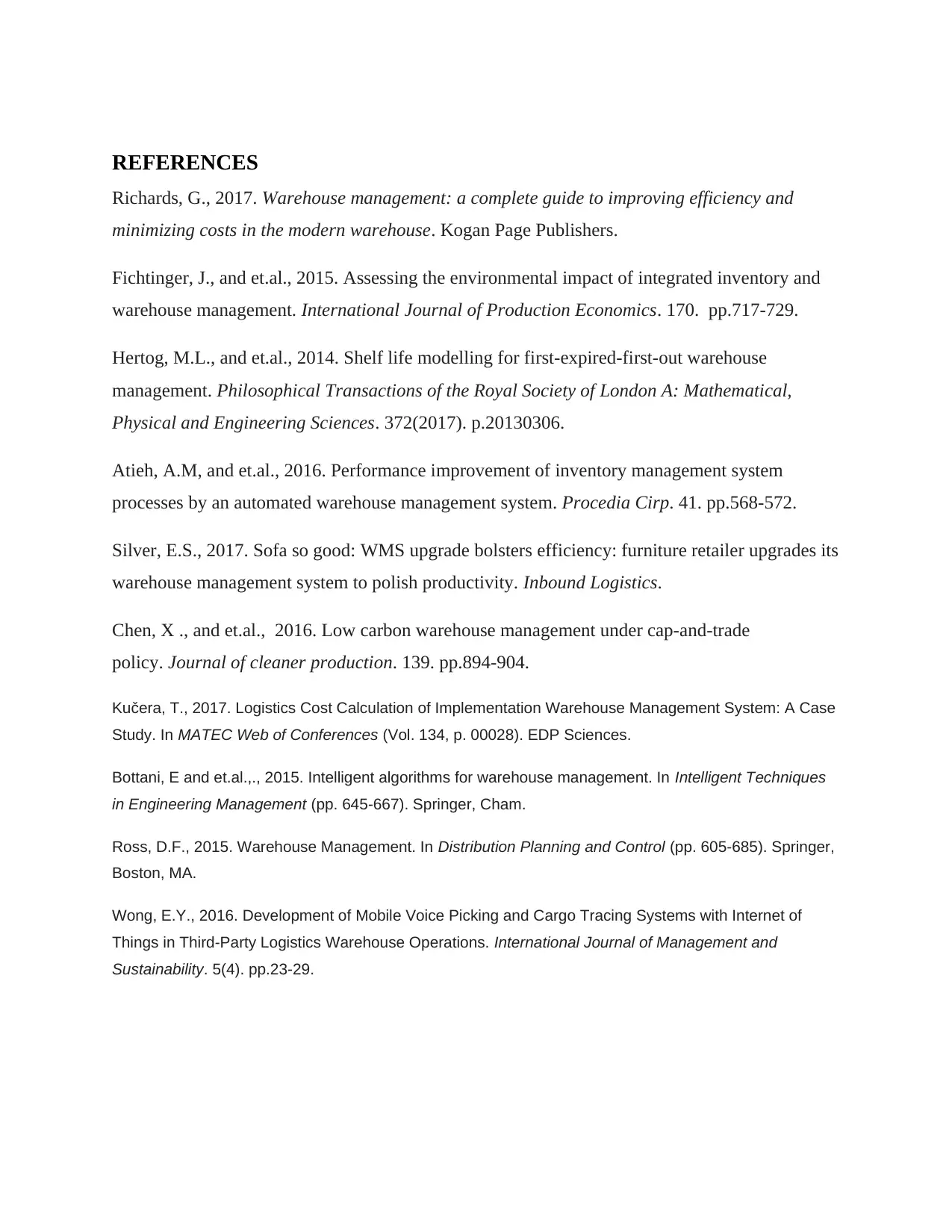
REFERENCES
Richards, G., 2017. Warehouse management: a complete guide to improving efficiency and
minimizing costs in the modern warehouse. Kogan Page Publishers.
Fichtinger, J., and et.al., 2015. Assessing the environmental impact of integrated inventory and
warehouse management. International Journal of Production Economics. 170. pp.717-729.
Hertog, M.L., and et.al., 2014. Shelf life modelling for first-expired-first-out warehouse
management. Philosophical Transactions of the Royal Society of London A: Mathematical,
Physical and Engineering Sciences. 372(2017). p.20130306.
Atieh, A.M, and et.al., 2016. Performance improvement of inventory management system
processes by an automated warehouse management system. Procedia Cirp. 41. pp.568-572.
Silver, E.S., 2017. Sofa so good: WMS upgrade bolsters efficiency: furniture retailer upgrades its
warehouse management system to polish productivity. Inbound Logistics.
Chen, X ., and et.al., 2016. Low carbon warehouse management under cap-and-trade
policy. Journal of cleaner production. 139. pp.894-904.
Kučera, T., 2017. Logistics Cost Calculation of Implementation Warehouse Management System: A Case
Study. In MATEC Web of Conferences (Vol. 134, p. 00028). EDP Sciences.
Bottani, E and et.al.,., 2015. Intelligent algorithms for warehouse management. In Intelligent Techniques
in Engineering Management (pp. 645-667). Springer, Cham.
Ross, D.F., 2015. Warehouse Management. In Distribution Planning and Control (pp. 605-685). Springer,
Boston, MA.
Wong, E.Y., 2016. Development of Mobile Voice Picking and Cargo Tracing Systems with Internet of
Things in Third-Party Logistics Warehouse Operations. International Journal of Management and
Sustainability. 5(4). pp.23-29.
Richards, G., 2017. Warehouse management: a complete guide to improving efficiency and
minimizing costs in the modern warehouse. Kogan Page Publishers.
Fichtinger, J., and et.al., 2015. Assessing the environmental impact of integrated inventory and
warehouse management. International Journal of Production Economics. 170. pp.717-729.
Hertog, M.L., and et.al., 2014. Shelf life modelling for first-expired-first-out warehouse
management. Philosophical Transactions of the Royal Society of London A: Mathematical,
Physical and Engineering Sciences. 372(2017). p.20130306.
Atieh, A.M, and et.al., 2016. Performance improvement of inventory management system
processes by an automated warehouse management system. Procedia Cirp. 41. pp.568-572.
Silver, E.S., 2017. Sofa so good: WMS upgrade bolsters efficiency: furniture retailer upgrades its
warehouse management system to polish productivity. Inbound Logistics.
Chen, X ., and et.al., 2016. Low carbon warehouse management under cap-and-trade
policy. Journal of cleaner production. 139. pp.894-904.
Kučera, T., 2017. Logistics Cost Calculation of Implementation Warehouse Management System: A Case
Study. In MATEC Web of Conferences (Vol. 134, p. 00028). EDP Sciences.
Bottani, E and et.al.,., 2015. Intelligent algorithms for warehouse management. In Intelligent Techniques
in Engineering Management (pp. 645-667). Springer, Cham.
Ross, D.F., 2015. Warehouse Management. In Distribution Planning and Control (pp. 605-685). Springer,
Boston, MA.
Wong, E.Y., 2016. Development of Mobile Voice Picking and Cargo Tracing Systems with Internet of
Things in Third-Party Logistics Warehouse Operations. International Journal of Management and
Sustainability. 5(4). pp.23-29.
⊘ This is a preview!⊘
Do you want full access?
Subscribe today to unlock all pages.

Trusted by 1+ million students worldwide
1 out of 9
Related Documents
Your All-in-One AI-Powered Toolkit for Academic Success.
+13062052269
info@desklib.com
Available 24*7 on WhatsApp / Email
![[object Object]](/_next/static/media/star-bottom.7253800d.svg)
Unlock your academic potential
Copyright © 2020–2025 A2Z Services. All Rights Reserved. Developed and managed by ZUCOL.




